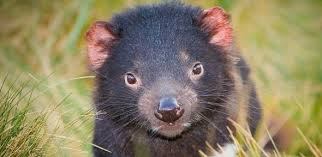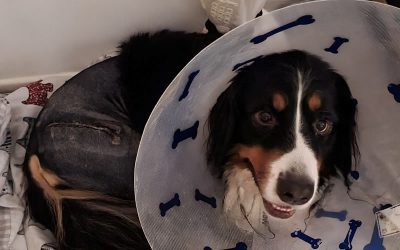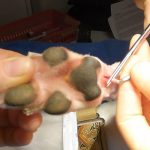 On a recent trip home to Australia we had a fascinating trip to a wildlife sanctuary which had a large breeding program for Tasmanian Devils. The Tassie Devil is perhaps better known from the oversized cartoon character whose main likeness to the true Devil is the aggressive, grumpy nature of Australia’s largest carnivorous marsupial.
On a recent trip home to Australia we had a fascinating trip to a wildlife sanctuary which had a large breeding program for Tasmanian Devils. The Tassie Devil is perhaps better known from the oversized cartoon character whose main likeness to the true Devil is the aggressive, grumpy nature of Australia’s largest carnivorous marsupial.
Just to get things straight from the start – a marsupial is a mammal that has a pouch where the young develop. Just like in kangaroos the babies are born in a very vulnerable & undeveloped state. The female Devil’s pouch contains only 4 teats so when the 20-30 young imps are born there is a scramble and only 4 will survive.
The four lucky ones stay in the pouch for another 4 months before first emerging. They will then live partly in the pouch and partly by clambering on mum’s back. They won’t be fully weaned for another 6 months.
Tasmanian Devils are carnivorous creatures. They will eat small lizards and rodents but primarily they survive on carrion which is often found by the roadside. Dead wallabies or wombats are quickly cleared as the Devils eat every part of the animal including the skin and hair, the bones and the organs; as well as the meat of course.
It is during feeding that they can be at their most vocal and aggressive. There are commonly skirmishes between Devils fighting over a dead carcass. The guttural cries which emanate are the presumed reason for their name.
Many of the Devils we saw in Tasmania had bald thickened faces and rumps which we were told is simply scarring from fighting wounds. The scars are a normal sign of age in these animals. Sadly the desire to fight with others has led to a sharp decline in their numbers in the past 20 years. A new infectious type of cancer has developed in the species which spreads with the natural fighting behaviour and causes tumours to develop on the lips & face. These become painful and will stop the animal from eating to the point where they will starve to death.
The Tassie Devil is currently in decline due to this cancer which started to afflict them in the mid 1990’s. There are many breeding programs with groups that are unaffected by the condition, in the hope of preventing their extinction. The belief is that a percentage of Devils will survive the disease and live to pass on their resistant genes to following generations but at this stage over 90% of the population in some areas have already gone.
If you’re interested in these amazing animals then have a look online – there are plenty of ways you can donate to help ensure the survival of a very unique Australian animal.
Building Plans for 2024
We have also commenced a major construction project externally which will add significantly to the facilities we can offer to our patients
Welcome to our NEW Reception & Waiting Room
Our aim was to make a beautiful space which we can all be proud of, but essentially, we needed to retain practicality and ergonomic design
Hip Hip Hooray for Ava
Ava is now seven months on from her surgery. She is very lively and is behaving like a puppy again!








